Super Smash Bros. is a crossover platform fighting game series published by Nintendo. The series was created by Masahiro Sakurai, who has directed every game in the series. The series is known for its unique gameplay objective which differs from that of traditional fighters, in that the aim is to increase damage counters and knock opponents off the stage instead of depleting life bars.
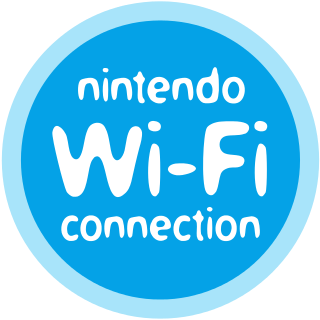
The Nintendo Wi-Fi Connection is a defunct online multiplayer gaming service run by Nintendo to provide free online play in compatible Nintendo DS and Wii games. The service included the company's Wii Shop Channel and DSi Shop game download services. It also ran features for the Wii and Nintendo DS systems.
The Virtual Console is a defunct line of downloadable video games for Nintendo's Wii and Wii U home video game consoles and the Nintendo 3DS family of systems.
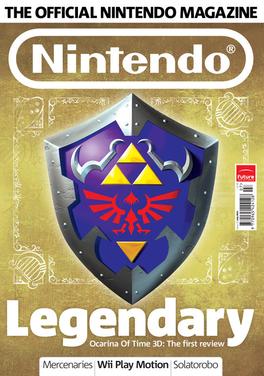
Official Nintendo Magazine, or ONM, was a British video game magazine that ran from 2006 to 2014 that covered the Nintendo DS, Nintendo 3DS, Wii, and Wii U video game consoles released by Nintendo.
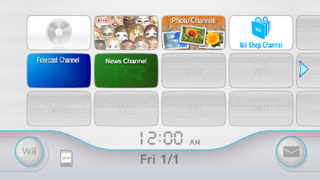
The Wii Menu is the graphical shell of the Wii and Wii U game console, as part of the Wii system software. It has four pages, each with a 4:3 grid, and each displaying the current time and date. Available applications, known as "channels", are displayed and can be navigated using the pointer capability of the Wii Remote. The grid is customizable; users can move channels among the menu's 48 customizable slots. By pressing the plus and minus buttons on the Wii Remote users can scroll across accessing empty slots.

A Mii is a customizable avatar used on several Nintendo video game consoles and mobile apps. The name Mii is a portmanteau of "Wii" and "me", referring to them typically being avatars of the players. Miis were first introduced on the Wii console in 2006 and later appeared on the DS, 3DS, the Wii U, the Switch, and various apps for smart devices such as Miitomo. Miis can be created using different body, facial and clothing features, and can then be used as characters within games on the consoles, either as an avatar of a specific player or in some games portrayed as characters with their own personalities. Miis can be shared and transferred between consoles, either manually or automatically with other users over the internet and local wireless communications.

The Japanese multinational consumer electronics company Nintendo has developed seven home video game consoles and multiple portable consoles for use with external media, as well as dedicated consoles and other hardware for their consoles. As of September 30, 2021, in addition to Nintendo Switch, Nintendo has sold over 863.07 million hardware units.
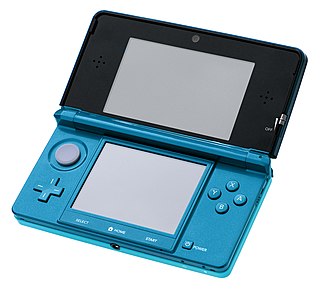
The Nintendo 3DS is a foldable handheld game console produced by Nintendo. The console was announced in March 2010 and unveiled at E3 2010 as the successor to the Nintendo DS. The system features backward compatibility with Nintendo DS video games. As an eighth-generation console, its primary competitor was Sony's PlayStation Vita.
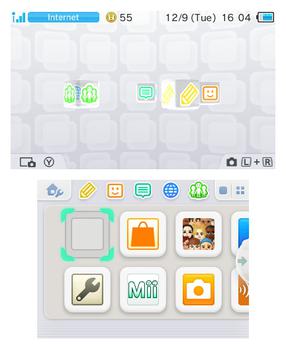
The Nintendo 3DS system software is a updatable operating system used for the Nintendo 3DS handheld system. The Nintendo Switch system software is believed to have evolved from the Nintendo 3DS operating system.
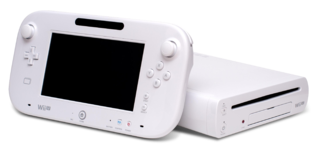
The Wii U is a home video game console developed by Nintendo as the successor to the Wii. Released in late 2012, it is the first eighth-generation video game console and competed with Microsoft's Xbox One and Sony's PlayStation 4.
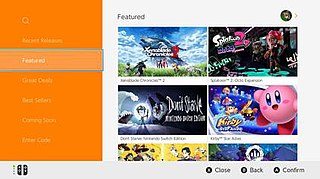
The Nintendo eShop is a digital distribution service for the Nintendo Switch, and formerly available via the Nintendo Network for the Wii U and Nintendo 3DS. The Nintendo eShop was first launched in June 2011 on the Nintendo 3DS via a system update that added the functionality to the HOME Menu. It is the successor to both the Wii Shop Channel and DSi Shop. Unlike on the Nintendo 3DS, the eShop was made available on the launch date of the Wii U, although a system update is required in order to access it. It is also a multitasking application, which means it is easily accessible even when a game is already running in the background through the system software, though this feature is exclusive to the Wii U and the Nintendo Switch. The Nintendo eShop features downloadable games, demos, applications, streaming videos, consumer rating feedback, and other information on upcoming game releases.
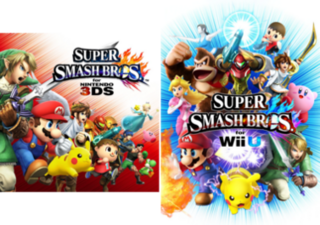
Super Smash Bros. for Nintendo 3DS and Super Smash Bros. for Wii U, both commonly referred together as Super Smash Bros. 4, are 2014 crossover platform fighter video games developed by Bandai Namco Studios and Sora Ltd. and published by Nintendo for the Nintendo 3DS and Wii U video game consoles. It is the fourth installment in the Super Smash Bros. series, succeeding Super Smash Bros. Brawl. The Nintendo 3DS version was released in Japan on September 13, 2014, and in North America, Europe, and Australia the following month. The Wii U version was released in North America, Europe, and Australia in November 2014 and in Japan the following month.
The eighth generation of video game consoles began in 2012, and consists of four home video game consoles: the Wii U released in 2012, the PlayStation 4 family in 2013, the Xbox One family in 2013, and the Nintendo Switch family in 2017.
Nintendo Network soon-to-be-defunct online service by Nintendo which provides free online functionality for the Nintendo 3DS and Wii U systems and their compatible games. Announced on January 26, 2012, at an investors' conference, it is Nintendo's second online service after Nintendo Wi-Fi Connection. Former president of Nintendo Satoru Iwata said, "Unlike Nintendo Wi-Fi Connection, which has been focused upon specific functionalities and concepts, we are aiming to establish a platform where various services available through the network for our consumers shall be connected via Nintendo Network service so that the company can make comprehensive proposals to consumers."

The Wii U operating system is the official firmware version and system software for the Nintendo's Wii U home video game console. Nintendo maintains the Wii U's systemwide features and applications by offering system software updates via the Internet. Updates are optional to each console owner, but may be required in order to retain interoperability with Nintendo's online services. Each update is cumulative, including all changes from previous updates.

Animal Crossing Plaza was a free to play social networking service developed and published by Nintendo for the Wii U. It was a spin-off of the Animal Crossing series, associated with Animal Crossing: New Leaf for the Nintendo 3DS. The application allowed players to socialize via Miiverse, Nintendo's now-defunct social networking service; players could share images from their New Leaf save file and interact with others, among other features. It was announced and released on August 7, 2013, in Japan and North America and the following day in Europe. The application is no longer actively supported by Nintendo, and was removed from the Nintendo eShop on December 22, 2014.
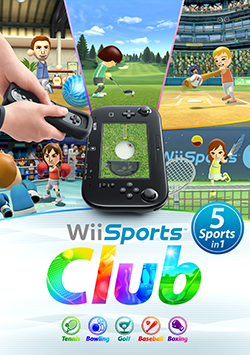
Wii Sports Club is a sports simulation video game, developed by Nintendo and Bandai Namco Studios and published by Nintendo for the Wii U throughout 2013 and 2014. It is the third entry in the Wii Sports series, a part of the larger Wii series. As an enhanced remake of the 2006 Wii launch title Wii Sports, it includes five minigames that replicate Tennis, Baseball, Bowling, Golf, and Boxing, and are controlled with motion controls that replicate the sports. New to the game is additional control schemes using the Wii U GamePad, online multiplayer, and Wii Motion Plus support. Players are organized into clubs that represent different regions, and scores and stats are tracked on Nintendo's social network Miiverse. Players could also communicate with each other during and after online matches using Miiverse. Each sport can be purchased individually or rented for a certain amount of time via a pass.
Amiibo is a toys-to-life platform by Nintendo, which was launched in November 2014. It consists of a wireless communications and storage protocol for connecting figurines to the Wii U, Nintendo 3DS, and Nintendo Switch video game consoles. These figurines are similar in form and functionality to that of the Skylanders, Disney Infinity and Lego Dimensions series of toys-to-life platforms. The Amiibo platform was preannounced to potentially accommodate any form of toy, specifically including general plans for future card games. Amiibo use near field communication (NFC) to interact with supported video game software, potentially allowing data to be transferred in and out of games and across multiple platforms.

Splatoon is a 2015 third-person shooter video game developed and published by Nintendo for the Wii U. The game centers around Inklings—anthropomorphic cephalopodic lifeforms that can transform between humanoid and cephalopod forms and frequently engage in turf wars with each other and use a variety of weapons that produce and shoot colored ink while in humanoid form, or swim and hide in surfaces covered in their own colored ink while in their cephalopodic forms. Splatoon features several different game modes, including four-on-four online multiplayer and a single player campaign.

Mario vs. Donkey Kong: Tipping Stars is a 2015 puzzle-platform game developed by Nintendo Software Technology and published by Nintendo for the Nintendo 3DS and Wii U. It is the sixth game in the Mario vs. Donkey Kong series and the 200th video game featuring Mario. The game was released worldwide in March 2015 on the Nintendo eShop for all regions, except in Japan. This is the first Nintendo-published title to support a cross-purchase concept, and the first Nintendo 3DS title to support Miiverse stamps. If players buy one version, they receive a free download code for the other version.















